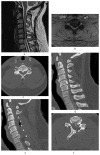Surgical outcome of laminoplasty for cervical spondylotic myelopathy: a single-institution experience
- PMID: 33890448
- PMCID: PMC10734866
- DOI: 10.3906/sag-2102-308
Surgical outcome of laminoplasty for cervical spondylotic myelopathy: a single-institution experience
Abstract
Background/aim: Cervical spondylotic myelopathy (CSM) develops as a result of compression of the spinal cord in the cervical region. Early diagnosis and surgical treatment can limit the progression of symptoms. Various surgical approaches and strategies have been described in the literature. This study aims to evaluate the clinical and radiological results of open-door laminoplasty for the treatment of CSM.
Materials and methods: In this study, we retrospectively analyzed the patients who underwent expansive open-door laminoplasty secured with titanium miniplates. Thirty-four patients with CSM who were followed up postoperatively for more than 12 months were included in the study. The modified Japanese Orthopaedic Association (mJOA) score was used to assess the degree of myelopathy. We evaluated cervical sagittal alignment with C2–C7 Cobb angle, the ambulatory status with the Nurick grade, and measured postoperative neck pain with the visual analogue scale (VAS).
Results: Themeanm JOA score was 11 (range 6–15) preoperatively, and 13.5 (range 9–16) postoperatively with an average 55% recovery rate (range 0–75) (p < 0.001). Themean–Nurick grade was 2 (range 1–3) preoperatively and 1 (range 0–3) postoperatively (p < 0.001). The median cervical lordotic angle increased from 7.5 ° preoperatively to 12.5 ° postoperatively (p = 0.044). K-line (+) patients› mean mJOA scores significantly increased from 10.8 ± 1.7 to 13.3 ± 1.7 postoperatively (p < 0.001). The mean preoperative VAS reduced from 2.66 ± 1.4 to 1.59 ± 1.4 postoperatively (p < 0.001).
Conclusion: Open-door laminoplasty technique is an effective surgical procedure that can be used safely to treat cervical spondylotic myelopathy. Our findings suggest that it can limit the progression of symptoms and alter the poor prognosis in CSM.
Keywords: K-line; laminoplasty; sagittal balance; Cervical spondylotic myelopathy.
This work is licensed under a Creative Commons Attribution 4.0 International License.
Conflict of interest statement
The authors declare that the study has not received any funding and there are no conflicts of interest.
Figures





References
MeSH terms
LinkOut - more resources
Full Text Sources
Other Literature Sources
Medical
Miscellaneous

